
The Sapotaceae are a family of flowering plants belonging to the order Ericales. The family includes about 800 species of evergreen trees and shrubs in around 65 genera. Their distribution is pantropical.

Manilkara is a genus of trees in the family Sapotaceae. They are widespread in tropical and semitropical locations, in Africa, Madagascar, Asia, Australia, and Latin America, as well as various islands in the Pacific and in the Caribbean. A close relative is the genus Pouteria.

Manilkara zapota, commonly known as sapodilla, sapota, chikoo, naseberry, or nispero is a long-lived, evergreen tree native to southern Mexico, Central America and the Caribbean. An example natural occurrence is in coastal Yucatán in the Petenes mangroves ecoregion, where it is a subdominant plant species. It was introduced to the Philippines during Spanish colonization. It is grown in large quantities in India, Pakistan, Thailand, Malaysia, Cambodia, Indonesia, Vietnam, Bangladesh and Mexico.

Mammea americana, commonly known as mammee, mammee apple, mamey, mamey apple, Santo Domingo apricot, tropical apricot, or South American apricot, is an evergreen tree of the family Calophyllaceae, whose fruit is edible. It has also been classified as belonging to the family Guttiferae Juss. (1789), which would make it a relative of the mangosteen.

Sapote is a term for a soft, edible fruit. The word is incorporated into the common names of several unrelated fruit-bearing plants native to Mexico, Central America and northern parts of South America. It is also known in Caribbean English as soapapple.
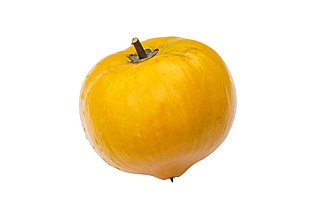
Pouteria campechiana is an evergreen tree native to, and cultivated in, southern Mexico, Belize, Guatemala, and El Salvador. It is cultivated in other countries, such as India, Costa Rica, Brazil, the United States, the Dominican Republic, Australia, Cambodia, Vietnam, Indonesia, India, Sri Lanka, Nigeria, and the Philippines. The edible part of the tree is its fruit, which is colloquially known as an egg fruit.
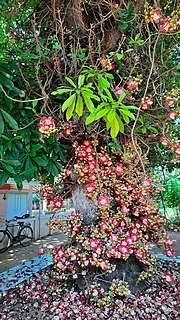
Couroupita guianensis, known by a variety of common names including cannonball tree, is a deciduous tree in the family Lecythidaceae. It is native to the tropical forests of Central and South America, and it is cultivated in many other tropical areas throughout the world because of its beautiful, fragrant flowers and large, interesting fruits. Fruits are brownish grey. There are medicinal uses for many parts of Couroupita guianensis, and the tree has cultural and religious significance in India.

Lansium parasiticum, commonly known as langsat, lanzones, or longkong in English; duku in Indonesian or dokong in Malay, is a species of tree in the Mahogany family with commercially cultivated edible fruits. The species is native to Southeast Asia.

Pouteria is a genus of flowering trees in the gutta-percha family, Sapotaceae. The genus is widespread throughout the tropical regions of the world. It includes the canistel, the Mamey sapote, and the lucuma. Commonly, this genus is known as pouteria trees, or in some cases, eggfruits.

Pouteria sapota, the mamey sapote, is a species of tree native to Cuba and Central America, naturally ranging from southern Cuba to southern Costa Rica, plus Mexico. Today, the tree is cultivated not only in Cuba, but also in Central America, the Caribbean, and South Florida for its fruit, which is commonly eaten in many Latin American countries. Mamey can be found in many Latin American communities throughout the USA, where it is made into milkshakes and ice cream among other foods.

Garcinia intermedia is a species of tropical American tree which produces tasty fruit. In English it is known as the lemon drop mangosteen. In Spanish it is called mameyito, though it is known as jorco in Costa Rica. In the Philippines, it is known as berba. In Portuguese it is called achachairu. The name achachairu is also applied to Garcinia humilis, another species native to Bolivia with larger, round or egg-shaped fruit. G. humilis has been commercialized in Australia under the name Achacha.

Pouteria caimito, the abiu, is a tropical fruit tree originated in the Amazonian region of South America. It grows to an average of 33 feet (10 m) high, and can grow as high as 116 feet (35 m) under good conditions. Its fruits' shape varies from round to oval, pointed at the distal end. When ripe, it has smooth, bright yellow skin and has one to four ovate seeds. The inside of the fruit is translucent and white. It has a creamy and jelly-like texture and its taste is similar to the sapodilla — a sweet caramel custard. The abiu tree is part of the family Sapotaceae and is very similar in appearance to the canistel.
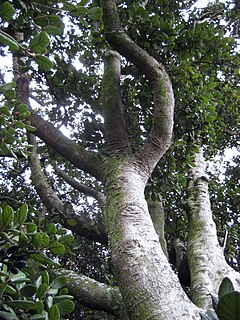
Beilschmiedia tarairi, commonly called taraire, is a tree of the family Lauraceae, endemic to the North Island of New Zealand. It is a common canopy tree in lowland forests north of Auckland, often growing in association with kauri, pohutukawa, tawapou, and puriri on basalt rocks and soils. Beilschmiedia is a genus of about 40 mainly tropical trees and shrubs with alternate to opposite leaves.

Pouteria australis, also known by the synonym Planchonella australis, is a medium to tall rainforest tree of the family Sapotaceae native to Queensland and New South Wales, Australia. It is known by the common name black apple, wild plum, yellow buttonwood, black plum and yellow bulletwood.
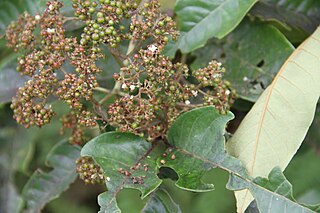
Harungana madagascariensis is a flowering plant found in Madagascar that is commonly known as the dragon's blood tree, orange-milk tree or haronga.
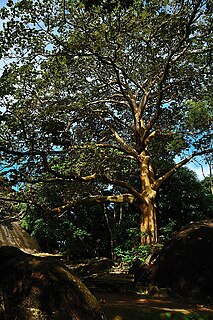
Sterculia apetala, commonly known as the Panama tree, camoruco, manduvi tree or anacagüita, is a species of flowering plants in the family Malvaceae. It is found in Central and South America, as well as the Caribbean islands. Sterculia apetala is recognized as the national tree of the Republic of Panama.
Sapote oil, sapuyul oil, or sapayulo oil is pressed from the seeds of the mamey sapote, a fruit tree native to South America. The oil is described as having an "almond-like odor" and a "mild, pleasant taste", and is also used as a cooking oil in some tropical countries.
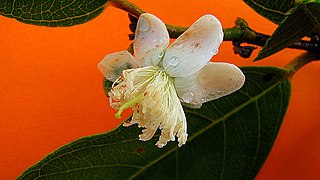
Psidium guineense is a species of guava.

Casimiroa is a genus of flowering plants in the family Rutaceae. It includes about 10 species native to Mexico and Central America. The genus is named for "an Otomi Indian, Casimiro Gómez, from the town of Cardonal in Hidalgo, Mexico, who fought and died in Mexico's war of independence."
Parkia bicolor, the African locust-bean, is a species of flowering plant, a tree in the pea family, Fabaceae. It is native to tropical West and Central Africa. Its natural habitats are tropical moist lowland forests, swampland, woodland and savannah.


















